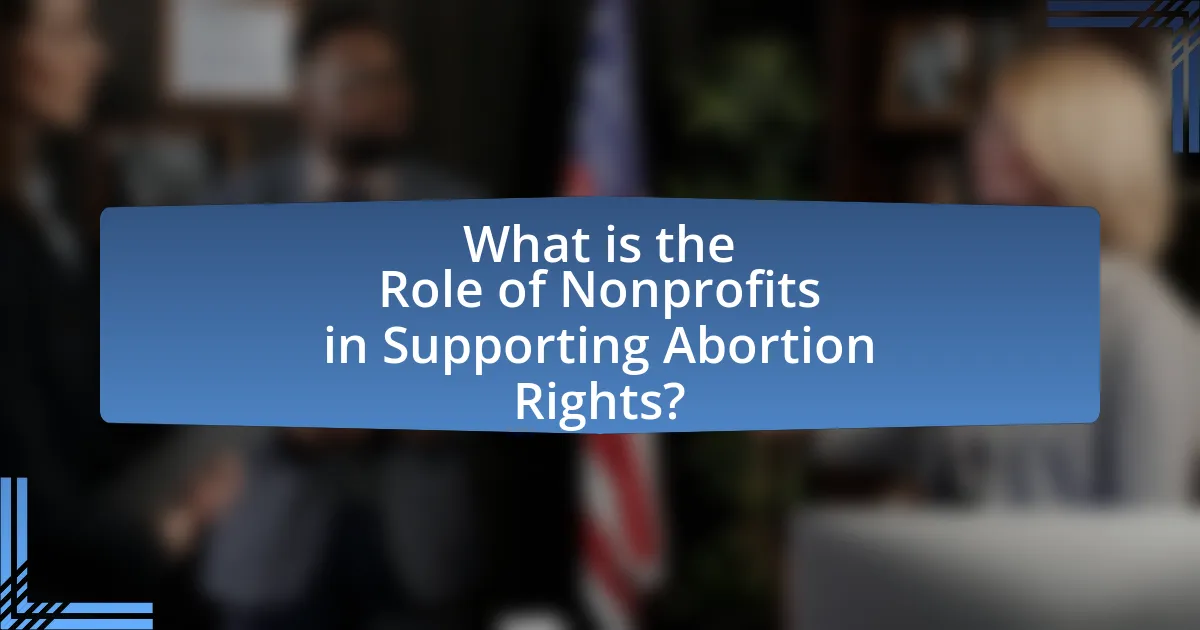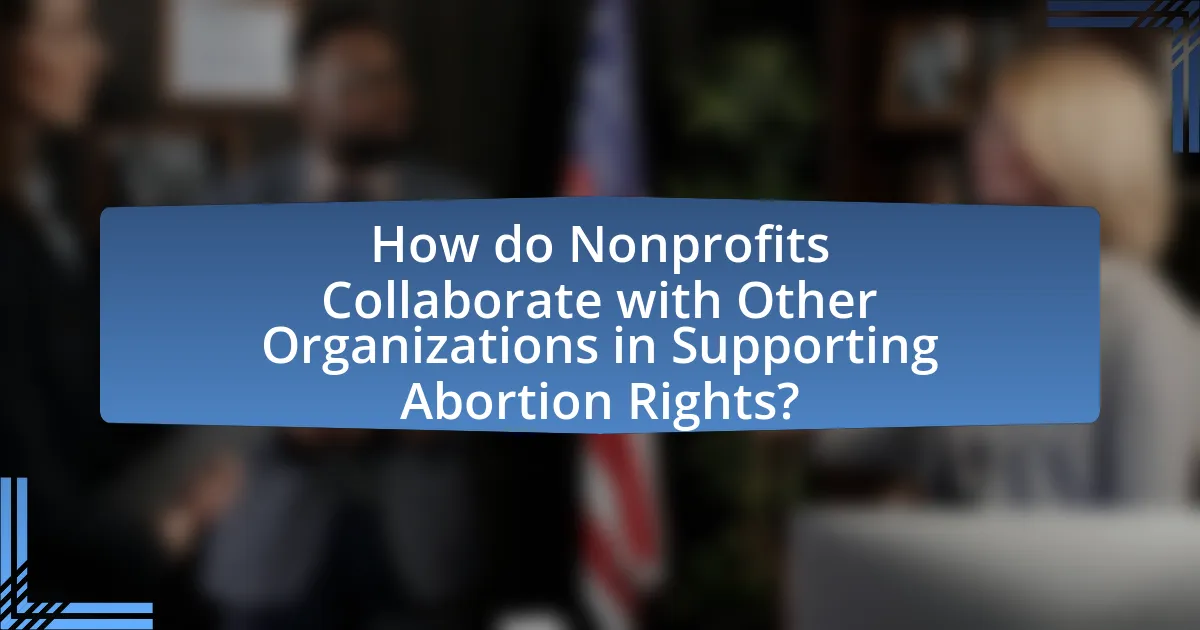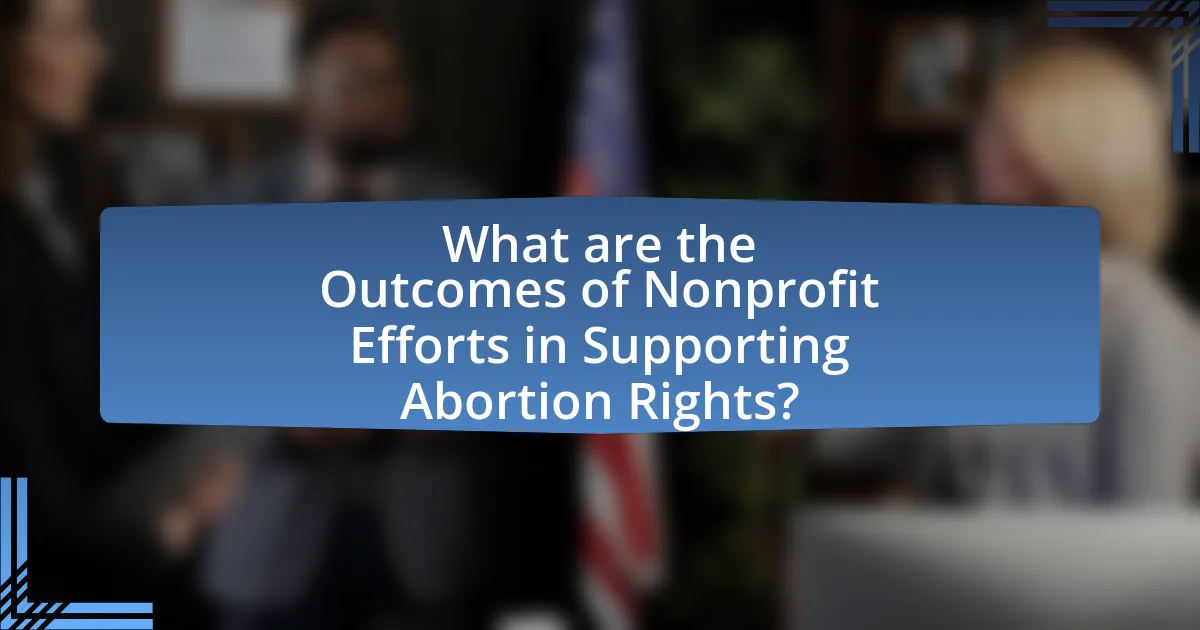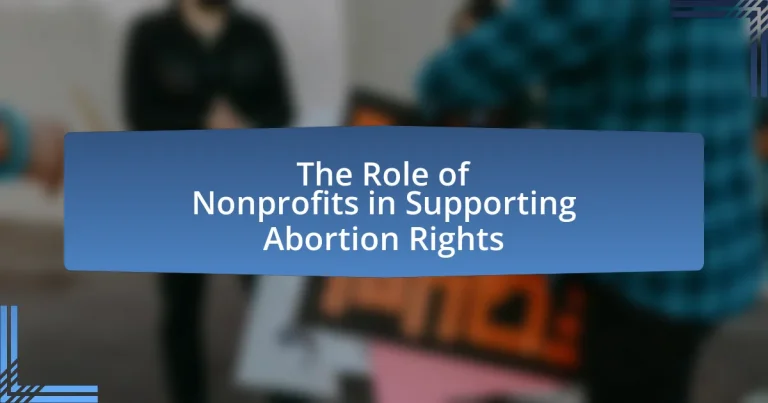Nonprofits play a vital role in supporting abortion rights through advocacy, education, and direct services. They influence legislation, mobilize grassroots efforts, and provide essential resources such as funding for clinics and counseling services. The article examines the various strategies employed by nonprofits, including grassroots mobilization and coalition building, and highlights the challenges they face, such as legal restrictions and funding limitations. It also discusses the impact of these organizations on public awareness and policy changes, emphasizing their importance in ensuring access to reproductive healthcare. Additionally, the article explores how collaborations with other organizations enhance advocacy efforts and the metrics used to measure the success of nonprofit initiatives in this area.

What is the Role of Nonprofits in Supporting Abortion Rights?
Nonprofits play a crucial role in supporting abortion rights by advocating for policy changes, providing education, and offering direct services. These organizations work to influence legislation that protects reproductive rights, such as lobbying for the repeal of restrictive laws and promoting access to safe abortion services. For instance, the Guttmacher Institute reports that nonprofit organizations have been instrumental in increasing public awareness and mobilizing grassroots efforts to safeguard abortion access, particularly in states with hostile legislation. Additionally, nonprofits often provide funding for clinics, offer counseling services, and create educational resources to empower individuals in making informed choices about their reproductive health.
How do nonprofits contribute to the advocacy for abortion rights?
Nonprofits contribute to the advocacy for abortion rights by providing resources, education, and support to individuals and communities. These organizations often engage in lobbying efforts to influence legislation, mobilize grassroots campaigns, and raise public awareness about reproductive rights. For instance, organizations like Planned Parenthood and the National Abortion Federation offer educational programs that inform the public about reproductive health options and legal rights. Additionally, nonprofits frequently collaborate with other advocacy groups to amplify their impact, as seen in coalitions formed to protect access to abortion services during legislative challenges. Their efforts are crucial in shaping public policy and ensuring that reproductive rights are upheld, as evidenced by the significant role they played in mobilizing opposition to restrictive abortion laws in various states.
What specific strategies do nonprofits employ in their advocacy efforts?
Nonprofits employ various strategies in their advocacy efforts, including grassroots mobilization, coalition building, public education campaigns, and lobbying. Grassroots mobilization involves engaging community members to participate in advocacy activities, which can amplify voices and increase pressure on policymakers. Coalition building allows nonprofits to unite with other organizations to strengthen their influence and resources, enhancing their collective impact on issues related to abortion rights. Public education campaigns aim to raise awareness and inform the public about abortion rights, utilizing social media, workshops, and informational materials to disseminate accurate information. Lobbying efforts focus on directly influencing legislators and government officials to support policies that protect and expand abortion rights, often involving meetings, testimony at hearings, and strategic communication. These strategies are supported by evidence showing that coordinated advocacy efforts can lead to significant policy changes and increased public support for abortion rights.
How do these strategies vary across different regions or demographics?
Strategies employed by nonprofits in supporting abortion rights vary significantly across different regions and demographics due to cultural, legal, and socio-economic factors. For instance, in regions with restrictive abortion laws, such as certain states in the U.S., nonprofits often focus on legal advocacy and providing resources for safe access, while in more liberal areas, they may emphasize education and outreach programs. Additionally, demographic factors such as age, race, and socio-economic status influence the approach; younger populations may engage more through digital campaigns, whereas older demographics might prefer community-based initiatives. Research indicates that in areas with higher poverty rates, nonprofits prioritize financial assistance for reproductive health services, reflecting the unique challenges faced by those communities.
Why are nonprofits essential in the fight for abortion rights?
Nonprofits are essential in the fight for abortion rights because they provide critical resources, advocacy, and support services that empower individuals to access reproductive healthcare. These organizations often mobilize grassroots efforts, educate the public on reproductive rights, and lobby for policy changes that protect and expand access to abortion services. For instance, the Guttmacher Institute reports that nonprofit organizations play a significant role in funding and operating clinics, particularly in underserved areas, ensuring that individuals have the necessary access to safe and legal abortion options. Additionally, nonprofits often offer counseling, legal assistance, and financial support, which are vital for those facing barriers to care.
What unique resources do nonprofits provide that government entities may not?
Nonprofits provide unique resources such as specialized advocacy, community engagement, and tailored services that government entities may not offer. Nonprofits often focus on specific issues, like abortion rights, allowing them to mobilize grassroots support and create targeted campaigns that resonate with local communities. For instance, organizations like Planned Parenthood offer direct services, education, and outreach that are often more flexible and responsive to community needs compared to government programs. Additionally, nonprofits can leverage private funding and donations to support initiatives that may not receive government backing, enabling them to fill gaps in services and advocacy.
How do nonprofits mobilize community support for abortion rights?
Nonprofits mobilize community support for abortion rights through grassroots organizing, advocacy campaigns, and educational initiatives. These organizations often engage local communities by hosting events, providing resources, and fostering discussions that raise awareness about reproductive rights. For instance, nonprofits like Planned Parenthood and the National Abortion Federation utilize social media platforms to disseminate information and mobilize supporters during critical legislative moments, such as the introduction of restrictive abortion laws. Additionally, studies show that community-based efforts, such as door-to-door canvassing and coalition-building with other local organizations, significantly enhance public support for abortion rights, demonstrating the effectiveness of these strategies in creating a more informed and engaged community.
What challenges do nonprofits face in supporting abortion rights?
Nonprofits face significant challenges in supporting abortion rights, primarily due to legal restrictions, funding limitations, and societal stigma. Legal restrictions vary by state and can include laws that limit access to abortion services, which complicates the ability of nonprofits to provide support and resources. Funding limitations arise as many donors may hesitate to contribute to organizations involved in abortion rights due to personal beliefs or political pressures, leading to financial instability for these nonprofits. Societal stigma surrounding abortion can also hinder outreach efforts, making it difficult for nonprofits to connect with individuals who need support. These challenges collectively impact the effectiveness and reach of nonprofits dedicated to advocating for and supporting abortion rights.
How do legal and political environments impact nonprofit operations?
Legal and political environments significantly impact nonprofit operations by shaping the regulatory framework and funding opportunities available to these organizations. Nonprofits must navigate laws regarding tax-exempt status, fundraising, and compliance with state and federal regulations, which can vary widely across jurisdictions. For instance, changes in legislation, such as the repeal or introduction of laws affecting abortion rights, can directly influence the mission and activities of nonprofits focused on reproductive health. Additionally, political climates can affect public perception and support for nonprofit initiatives, as seen in the fluctuating funding for organizations advocating for abortion rights, which often correlates with the political party in power. Thus, the legal and political contexts are crucial determinants of how effectively nonprofits can operate and fulfill their missions.
What funding obstacles do nonprofits encounter in their mission?
Nonprofits encounter several funding obstacles in their mission, particularly in the context of supporting abortion rights. One significant challenge is the restriction of funds from certain foundations and donors who may have ideological opposition to abortion, limiting the financial resources available for advocacy and support. Additionally, nonprofits often face competition for grants and donations, which can be exacerbated by economic downturns that reduce overall philanthropic giving. According to a report by the National Council of Nonprofits, 70% of nonprofits reported that funding was a significant barrier to achieving their missions, highlighting the pervasive nature of this issue.

How do Nonprofits Collaborate with Other Organizations in Supporting Abortion Rights?
Nonprofits collaborate with other organizations in supporting abortion rights through partnerships, resource sharing, and joint advocacy efforts. These collaborations often involve aligning missions with reproductive health organizations, legal advocacy groups, and grassroots movements to amplify their impact. For instance, nonprofits may co-host events, share research and data on reproductive rights, and mobilize community support through coordinated campaigns. A notable example is the collaboration between Planned Parenthood and the American Civil Liberties Union, which has worked together on legal challenges to restrictive abortion laws, demonstrating the effectiveness of united efforts in protecting reproductive rights.
What partnerships are most effective for nonprofits in this area?
Collaborations with healthcare providers, legal advocacy organizations, and grassroots community groups are the most effective partnerships for nonprofits supporting abortion rights. These partnerships enhance access to reproductive health services, provide legal support for individuals facing restrictions, and mobilize community engagement. For instance, organizations like Planned Parenthood often partner with local health departments to ensure comprehensive care, while legal groups like the Center for Reproductive Rights work alongside nonprofits to challenge restrictive laws, demonstrating the effectiveness of these collaborations in advancing abortion rights.
How do collaborations enhance the impact of abortion rights advocacy?
Collaborations enhance the impact of abortion rights advocacy by pooling resources, expertise, and networks among various organizations. When nonprofits, grassroots groups, and advocacy organizations work together, they can amplify their messaging, reach broader audiences, and mobilize more supporters. For instance, joint campaigns can leverage the strengths of each partner, such as legal expertise from one organization and grassroots mobilization from another, creating a more comprehensive approach to advocacy. Research shows that collaborative efforts can lead to increased funding and visibility; for example, the National Network of Abortion Funds has successfully partnered with local organizations to raise awareness and provide financial assistance, demonstrating the effectiveness of collaboration in achieving shared goals.
What role do coalitions play in strengthening nonprofit efforts?
Coalitions play a crucial role in strengthening nonprofit efforts by enhancing collaboration, resource sharing, and collective advocacy. By uniting various organizations with similar goals, coalitions amplify their impact, allowing for a more significant reach and influence in policy-making and community engagement. For instance, coalitions focused on abortion rights can combine expertise, funding, and grassroots mobilization, leading to more effective campaigns and initiatives. Research shows that collaborative efforts can increase the likelihood of achieving policy changes, as seen in the success of coalitions like the National Abortion Federation, which has effectively advocated for reproductive rights through unified action.
How do nonprofits engage with grassroots movements?
Nonprofits engage with grassroots movements by providing resources, advocacy, and organizational support to amplify local efforts. They often collaborate with grassroots organizations to mobilize community members, share information, and coordinate campaigns that align with their missions. For instance, nonprofits like Planned Parenthood have partnered with local activists to organize rallies and educational events, effectively increasing awareness and participation in abortion rights advocacy. This collaboration is crucial, as it leverages the grassroots’ local knowledge and the nonprofits’ broader networks and funding capabilities, enhancing the overall impact of the movement.
What methods do nonprofits use to empower local activists?
Nonprofits empower local activists through training programs, resource provision, and community organizing. Training programs equip activists with skills in advocacy, public speaking, and grassroots mobilization, enhancing their effectiveness in promoting abortion rights. Resource provision includes access to legal information, funding for initiatives, and materials that support awareness campaigns. Community organizing fosters collaboration among activists, creating networks that amplify their voices and efforts. For example, organizations like Planned Parenthood provide workshops and grants that directly support local initiatives aimed at advancing reproductive rights.
How does grassroots involvement influence nonprofit strategies?
Grassroots involvement significantly influences nonprofit strategies by ensuring that the needs and perspectives of the community are prioritized in decision-making processes. Nonprofits that engage with grassroots movements often adapt their strategies to reflect the voices of those they serve, leading to more effective advocacy and resource allocation. For instance, organizations like Planned Parenthood have incorporated grassroots feedback to tailor their services and outreach efforts, resulting in increased community trust and participation. This alignment with grassroots sentiments not only enhances the relevance of nonprofit initiatives but also fosters stronger community ties, ultimately driving more impactful outcomes in supporting abortion rights.

What are the Outcomes of Nonprofit Efforts in Supporting Abortion Rights?
Nonprofit efforts in supporting abortion rights have led to increased access to reproductive healthcare, enhanced public awareness, and strengthened legal protections for abortion services. For instance, organizations like Planned Parenthood have expanded clinic networks, providing millions of individuals with essential reproductive health services, including abortion. According to the Guttmacher Institute, in 2020, 93% of U.S. counties lacked an abortion provider, highlighting the critical role nonprofits play in addressing this gap. Additionally, advocacy campaigns by nonprofits have successfully influenced legislation, resulting in the protection of abortion rights in various states, as evidenced by the passage of laws that safeguard access against restrictive measures. These outcomes demonstrate the significant impact of nonprofit organizations in advancing and securing abortion rights.
How can the success of nonprofit initiatives be measured?
The success of nonprofit initiatives can be measured through specific metrics such as program outcomes, financial sustainability, stakeholder engagement, and community impact. Program outcomes assess the effectiveness of services provided, often evaluated through surveys and data collection that reflect changes in knowledge, behavior, or conditions among beneficiaries. Financial sustainability is measured by analyzing revenue streams, funding diversity, and cost management, which indicate the organization’s ability to maintain operations over time. Stakeholder engagement is evaluated through participation rates, volunteer involvement, and partnerships, demonstrating the organization’s reach and influence. Community impact is assessed through qualitative and quantitative data that show improvements in community health, access to services, or policy changes resulting from the nonprofit’s efforts. These metrics provide a comprehensive view of a nonprofit’s effectiveness in achieving its mission, particularly in supporting abortion rights initiatives.
What metrics are used to evaluate the effectiveness of advocacy campaigns?
Metrics used to evaluate the effectiveness of advocacy campaigns include engagement rates, policy changes, public awareness levels, and fundraising success. Engagement rates measure how many individuals participate in campaigns through actions like signing petitions or attending events, indicating the campaign’s reach and resonance. Policy changes reflect the tangible outcomes of advocacy efforts, such as new legislation or amendments that align with campaign goals. Public awareness levels can be assessed through surveys or media coverage, showing how well the campaign has informed and influenced public opinion. Fundraising success indicates the financial support garnered, which can be a direct measure of the campaign’s perceived importance and effectiveness. These metrics collectively provide a comprehensive view of an advocacy campaign’s impact and success.
How do success stories from nonprofits shape public perception of abortion rights?
Success stories from nonprofits significantly shape public perception of abortion rights by highlighting the positive impact of access to reproductive healthcare. These narratives often showcase individual experiences where nonprofits have successfully provided support, education, and resources, leading to improved health outcomes and empowered decision-making for women. For instance, organizations like Planned Parenthood have documented cases where their services have enabled women to make informed choices, thereby fostering a more favorable view of abortion rights among the public. Research indicates that personal stories resonate more deeply with audiences, making them more likely to support policies that protect reproductive rights. This connection between success stories and public perception is crucial, as it helps to humanize the issue and counteract stigma associated with abortion.
What lessons can be learned from successful nonprofit campaigns?
Successful nonprofit campaigns demonstrate the importance of clear messaging and community engagement. Effective campaigns often utilize targeted communication strategies that resonate with their audience, ensuring that the mission and goals are easily understood. For instance, the Planned Parenthood Federation of America has successfully mobilized support through clear, consistent messaging about reproductive rights, which has led to increased public awareness and advocacy. Additionally, successful campaigns often leverage data and storytelling to connect emotionally with supporters, as seen in the work of organizations like NARAL Pro-Choice America, which combines personal narratives with statistics to highlight the impact of policies on individuals. These strategies not only enhance visibility but also foster a sense of community and shared purpose among supporters, ultimately driving greater participation and funding.
What best practices have emerged from effective nonprofit strategies?
Effective nonprofit strategies have emerged best practices such as building strong community partnerships, leveraging data for decision-making, and ensuring transparency in operations. Strong community partnerships enhance outreach and resource sharing, which is crucial for nonprofits focused on abortion rights, as evidenced by organizations like Planned Parenthood, which collaborates with local groups to expand access to services. Leveraging data allows nonprofits to assess needs and measure impact, exemplified by the Guttmacher Institute’s research that informs policy advocacy. Transparency fosters trust and accountability, essential for maintaining donor support and community engagement, as demonstrated by the financial disclosures of successful nonprofits.
How can these practices be applied to future advocacy efforts?
These practices can be applied to future advocacy efforts by leveraging data-driven strategies, community engagement, and coalition-building. Nonprofits can utilize data analytics to identify key demographics and tailor their messaging effectively, as evidenced by the success of organizations like Planned Parenthood, which has used targeted outreach to increase awareness and support for abortion rights. Additionally, fostering community involvement through grassroots campaigns can enhance local support, as seen in various state-level initiatives that mobilized volunteers and resources to advocate for reproductive rights. Lastly, forming coalitions with other organizations amplifies the advocacy message, creating a unified front that can influence policy changes, demonstrated by the collaborative efforts of nonprofits during legislative battles in multiple states.
What practical steps can individuals take to support nonprofits in this cause?
Individuals can support nonprofits advocating for abortion rights by making financial contributions, volunteering time, and raising awareness through social media. Financial donations provide essential resources for nonprofits to operate and expand their services; for instance, the Guttmacher Institute reported that funding is crucial for research and advocacy efforts. Volunteering allows individuals to contribute skills and labor directly to nonprofit initiatives, enhancing their impact. Additionally, sharing information and resources on social media can amplify the nonprofit’s message, reaching a broader audience and fostering community engagement. These actions collectively strengthen the capacity of nonprofits to promote and protect abortion rights effectively.


